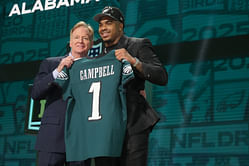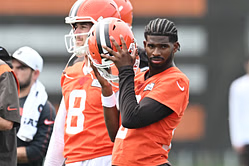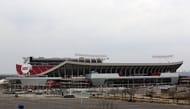
- Kansas City Chiefs Home Venue
- Arrowhead Stadium Capacity
- Arrowhead Stadium History
- Arrowhead Stadium Construction and Cost
- Arrowhead Stadium Seating Chart
- What does GEHA Stadium stand for?
- What to bring to Arrowhead Stadium?
- What is the parking cost at Arrowhead Stadium?
- What stadium was the Chiefs' original home stadium in Kansas City?
The location for the last 5 AFC Championship Games out of 6 years has been the same. Coinciding with the Kansas City Chiefs’ meteoric rise, Arrowhead Stadium has quickly become one of the premier destinations in the entire league. So, naturally, fans are curious about the stadium and what it represents. Today, we will take a deep dive into the Stadium and everything it stands for.
Kansas City Chiefs Home Venue
A little over 2 years after the 1970 NFL-AFL merger, the Arrowhead Stadium became the official host for all games involving the Kansas City Chiefs. More than half a century later, that statement still holds true. As a result of a deal between the Chiefs and GEHA, as of March 2021, the stadium is officially recognized as the GEHA Field at Arrowhead Stadium. This agreement runs through for a decade, in accordance with the lease for the Chiefs with the Jackson County Sports Complex Authority.
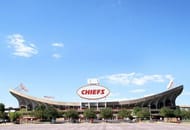
Located in Kansas City, Missouri, it is the 24th-largest stadium in the country and is a part of the Truman Sports Complex along with the Kauffman Stadium, the home of the Kansas City Royals of Major League Basketball. Further, the stadium is the fourth-largest in the NFL and is the largest in the entire state of Missouri.
Apart from Chiefs home games, the stadium also hosts some college football and soccer games. Most notably, it is scheduled to be one of the highlight destinations for the 2026 FIFA World Cup.
Arrowhead Stadium Capacity
The 4th-largest NFL stadium also happens to be the largest stadium in the entire state of Missouri in terms of capacity. At present day, the total maximum capacity of Arrowhead is 76,416. It has stayed at that number for more than a decade after some construction work prior to the 2010 season.
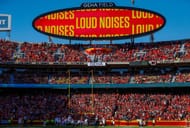
Before the remodeling, the structure located at 1 Arrowhead Drive used to house an even larger number of audience members. At the time of its inception, the stadium could support crowds of up to 78,097 members. That number would see minor increments in both 1995 and 1997 as the stadium would eventually end up at 79,451 capacity. Staying at that number for 13 years, the 2010 restructuring was the first time the total capacity saw a decline for the iconic location in the West of Memphis.
Arrowhead Stadium History
The Dallas Texans were a hugely successful franchise in the early stages of the AFL, even winning the AFL Championship in 1962 against the Houston Oilers. However, the following year, the team shifted to Kansas City and rebranded itself as the Chiefs. While they would play in a 35,000-capacity stadium for its first few years, the AFL-NFL merger brought with it some new laws.
One of them was the mandatory 50,000 capacity that each stadium would have to ensure. As a result, a new project courtesy of Jackson County was designed with a location on the eastern edge of KC near the Interstate 70 and Interstate 435 change. As a result, the stadium came into existence. However, not without some further controversy.
The initial design would see two stadiums constructed adjacent to one another. Between baseball and football, the two would give way for a new sports complex with a common roof that could be rolled over each side. However, complications in the design forced the committee to resort to the current structure and the open-air behemoth came into existence.
The stadium would finally become functional for the 1972 season. The first preseason game took place on August 12, 1972. Nearly 3 months later, on November 5th, the stadium would host its largest capacity crowd yet. Clocking in at 82,094 onlookers, the matchup between the Chiefs and the Oakland Raiders would see the home team score their first victory in their new home with a 27-14 scoreline.
The Arrowhead Stadium has also been inspirational. Its use of arrows to indicate goal lines at yard markers became the standard practice and was eventually converted into a mandated rule in 1978. The 1974 season saw the Stadium host its first Pro Bowl. While in jeopardy due to an ice storm leading up to the game, the actual day brought good fortunes as a warm temperature thawed the ice, giving way to an AFC victory.
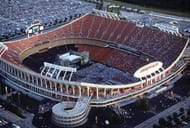
For the first 2 decades, Arrowhead would house artificial AstroTurf. But, in 1994, among other improvements, natural grass would become the standard practice. 3 years earlier, the stadium would also see the installation of two football-shaped Diamond Vision screens. The next major change would come during the reconstruction in 2009. Included was a multimillion-dollar integration of two HD video displays into the pre-existing football displays. Further, almost 500 meters of digital ribbon board technology was also added as a feature.
The Stadium would again change the nature of its field in 2013, this time shifting to NorthBridge Bermudagrass. The change became a compulsion to navigate the cold weather. Along with its rapid recovery and aggressive rooting features, the choice was obvious.
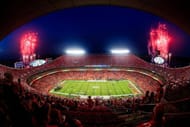
Arrowhead would see a name change in 2021 after the Chiefs sold the naming rights to GEHA, switching the Stadium to the GEHA Field at Arrowhead Stadium.
Arrowhead Stadium Construction and Cost
After Jackson County proposed the initial concept, voters approved of 102,000,000 bond issue in 1967. The following year, construction for the project began with the original two-stadium concept in mind. Designed by Denver architects Charles Deaton and Steadman, the unfeasibility of the structure led to a design change.
As a result, the far more complicated and expensive structure was replaced with the current model. Even though the baseball and football stadiums look very different, they do share the utility, parking, and underground storage space. While the initial plans included the stadiums to be covered, These ideas were dropped for the current two open-air stadium structures.

As a special ode to the owner. A suit was made, which comprised three bedrooms, bathrooms, a kitchen, and a living room that was designed according to the football stadium. In an effort to increase the seating capacity, steep inclined upper sections were constructed that would not be possible in today's accessibility regulations-heavy mandates.
Deaton's designs came to life as a result of the Kansas City Architectural Firm of Kivett & Myers. An influence on many designs in the future for NFL stadiums, the construction was a joint venture between the Sharp-Kidde-Webb Construction Firms and would end up costing nearly $43 million, an amount that would equate to $301 million in 2022. The remodeling in the 2007-2010 period would add another $375 million to the bill, almost $503 million in 2022.
Arrowhead Stadium Seating Chart
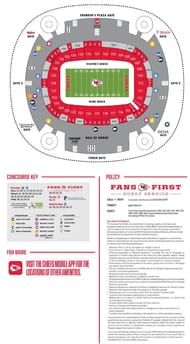
What does GEHA Stadium stand for?
As a part of a new deal with the GEHA group in 2021, the Chiefs sold the naming rights to the organization. As a result, their home field is now known as the GEHA Field at Arrowhead Stadium. The agreement coincides with the expiration of Kansas City Chiefs’ lease expiration on Arrowhead Stadium in 2031.
GEHA is the Government Employees Health Association, a non-profit organization founded in Kansas City, Missouri. With headquarters at the Lee’s Summitt in Missouri, the organization aims to provide medical and dental plans to federal employees and retirees and their families through the Federal Employees Health Benefits Program and the Federal Employees Dental and Vision Insurance Program. Annually, they help close to 2 million people worldwide.
What to bring to Arrowhead Stadium?
There is a long list of prohibited items not allowed at GEHA Field at Arrowhead Stadium. But, there are some items that can be taken in after inspection.
Prohibited Items List
All food and beverage items, except a 20oz factory-sealed water bottle
Glass, metal, plastic thermos, cups, bottles, or flasks
Backpacks, fanny packs, belt bags, cinch bags, coolers and bags larger than permissible size
Helmets and hardhats
Weapons including guns, knives, etc.
Fireworks
Flammable Liquids
Noisemakers like air horns or bells
Boom Boxes
Video or professional cameras
Laser pointers of any type
Portable Heaters
Large Strollers
Floor mats and carpet squares
Seat cushions, especially ones with pockets, zippers, compartments, or covers
Sports balls
Permitted but after Inspection
Clear plastic bags with a maximum size of 12” by 6” by 12”
Clear fanny packs and backpacks are also allowed
One-gallon clear plastic zip-seal bags
Small clutch bags (max size:4.5” by 6.5”)
Small still cameras under 6” without a case
Binoculars without a case
Hand-held radios and TVs with earpieces
Blankets
Banners, signs, and flags (Max size: 3’ by 5’)
Small compact umbrellas (cannot be opened inside the stadium)
Water Bottle (Factory sealed, 20oz or less)
Breast pumps and supplies
Portable Chargers (Max size: 6” by 3” by 1.5” and need to be disconnected during inspection)
Seat Cushions without pockets, zippers, compartments, and covers
What is the parking cost at Arrowhead Stadium?
The parking system at Arrowhead Stadium is a fairly straightforward process. You can either get parking passes for a single game or also get a full season-long pass.
As of September 2024, the cost of a single-game pass is dependent on the type of vehicle. Red Parking costs $50, whereas a Bus/RV takes up $130.
For season pass holders, there are 2 primary categories. Red Parking comes in at $370, whereas Gold Parking is for $630.
Further, Platinum Parking limited to CommunityAmerica Club Level STMs and Suite Members is for $800.
A limited quantity of Suite Members can get a Bus/RV season pass for $850 as well.
For accessibility options, look at the table below:
| GATE | PLATINUM | GOLD | RED | BUS/RV/LIMO |
| 1 | No | No access | No access | Northside of Dubiner Circle |
| 3 | Go to Gate 4 | Go to Gate 4 | C, B, A, L | No access |
| 4 | M | C, B | C, B, A, L | No access |
| 5 | E | F, D, B | F, D, N, O, A | No access |
| 6 | Go to Gate 7 | G, F, H | F, G, N, O | No access |
| 7 | M, E | G, H | No access | Northside of Dubiner Circle |
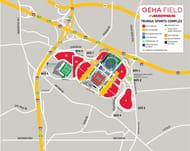
What stadium was the Chiefs' original home stadium in Kansas City?
As is increasingly clear and aforementioned, the Chiefs didn’t originally start off at the Arrowhead Stadium. Prior to construction and its inauguration in 1972, the Chiefs had two different homes.
In their first three seasons, the Dallas Texans used to conduct business out of the Cotton Bowl in Texas. After their move to Kansas City, the team would take over the Municipal Stadium as their home field. However, after the merging of the AFL and the NFL, the mandatory 50,000-capacity stadium led to the formation of the Arrowhead Stadium.
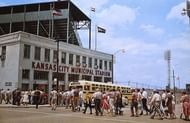
For more than half a century, Arrowhead has been a symbol of continuity for the Kansas City Chiefs. As the team looks poised for a decade-long run at the top with Patrick Mahomes at the helm, Arrowhead might remain its one true constant.
FAQs
A. Arrowhead Stadium stands as the 24th-biggest stadium in the USA. While it is the 4th-largest in the NFL, it also is the largest by capacity in the state of Missouri.
A. Arrowhead Stadium is famous for being the home field for the reigning NFL Champions, the Kansas City Chiefs since its construction in 1972.
A. Due to an agreement with GEHA, the stadium is now known as the GEHA Field at Arrowhead Stadium. The terms of the agreement expire in 2031, along with the Chiefs' lease for the Stadium.
A. While initially artificial AstroTurf, Arrowhead saw a shift to natural grass during renovations in 1994. But, they now use a special kind of grass to combat the weather called Bermudagrass.
